Alpheus (deity)
Alpheus or Alpheios (/ælˈfiːəs/; Ancient Greek: Ἀλφειός, meaning "whitish"), was in Greek mythology a river (the modern Alfeios River) and river god.[2]

Family
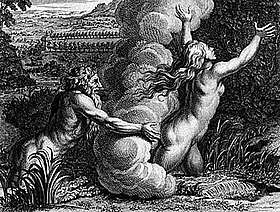
Like most river gods, he is a son of Oceanus and Tethys.[3][4] Telegone, daughter of Pharis, bore his son, the king Orsilochus.[5] Through him, Alpheus was the grandfather of Diocles, and great-grandfather of a pair of soldiers, Crethon and Orsilochus, who were slain by Aeneas during the Trojan War.[6] The river god was also called the father of Melantheia who became the mother of Eirene by Poseidon.[7] In later accounts, Alpheus (Alphionis) was the father of Phoenissa, possible mother of Endymion by Zeus.[8]
Mythology
According to Pausanias, Alpheus was a passionate hunter and fell in love with the nymph Arethusa, but she fled from him to the island of Ortygia near Syracuse, and metamorphosed herself into a well, after which Alpheus became a river, which flowing from the Peloponnese under the sea to Ortygia, there united its waters with those of the well Arethusa.[9][10] The well of Arethusa is a symbol of Syracuse.[11] This story is related somewhat differently by the Roman writer Ovid: Arethusa, a beautiful nymph, once while bathing in the river Alfeios in Arcadia, was surprised and pursued by the river god; but the goddess Artemis took pity upon her and changed her into a well, which flowed under the earth to the island of Ortygia.[12][13][14][15][16][17] Alpheus took on water form jumping into the stream, but the earth opened and the stream flew underground to appear in a bay near Syracuse, near the island Ortygia, a location sacred to Artemis.[18]
According to other traditions, Artemis herself was the object of the love of Alpheus. Once, it is said, when pursued by him she fled to Letrini in Elis, and here she covered her face and those of her companions (nymphs) with mud, so that Alpheus could not discover or distinguish her, and was obliged to return.[19] This occasioned the building of a temple of Artemis Alphaea at Letrini. According to another version, the goddess fled to Ortygia, where she had likewise a temple under the name of Alphaea.[20] An allusion to Alpheius' love of Artemis is also contained in the fact that at Olympia the two divinities had one altar in common.[21][22]
In these accounts two or more distinct stories seem to be mixed up together, but they probably originated in the popular belief that there was a natural subterranean communication between the river Alpheios and the well Arethusa. It was believed that a cup thrown into the Alpheius would make its reappearance in the well Arethusa in Ortygia.[23][24][25] Plutarch gives an account which is altogether unconnected with those mentioned above.[26] According to him, Alpheius was a son of Helios, and killed his brother Cercaphus in a contest. Haunted by despair and the Erinyes he leapt into the river Nyctimus which afterwards received the name Alpheius.[2]
Alpheus was also the river which Heracles, in the fifth of his labours, rerouted in order to clean the filth from the Augean Stables in a single day, a task which had been presumed to be impossible.
Roman References
Associated often with Antinous, the lover of the Roman Emperor Hadrian. Antinous was a Greek youth who had drowned in the Nile River. After he was deified, coins of the period depict him as Alpheios or Hadrian with Alpheios.[27]
Gallery
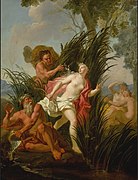 Alpheus chasing Arethusa by Antoine Coypel (18th-century)
Alpheus chasing Arethusa by Antoine Coypel (18th-century)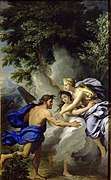 Alpheus and Arethusa by René-Antoine Houasse
Alpheus and Arethusa by René-Antoine Houasse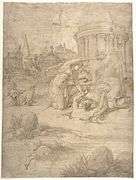 The Story of Arethusa by Francesco Primaticcio
The Story of Arethusa by Francesco Primaticcio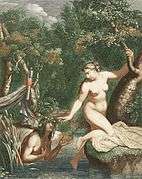 Alpheus and Arethusa by Abraham Bloteling (between 1655 and 1690)
Alpheus and Arethusa by Abraham Bloteling (between 1655 and 1690)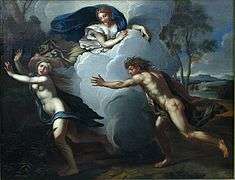 Alpheus and Arethusa (Roman School, circa 1640)
Alpheus and Arethusa (Roman School, circa 1640)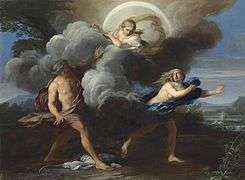 Alpheus and Arethusa by Carlo Maratta (7th-century)
Alpheus and Arethusa by Carlo Maratta (7th-century)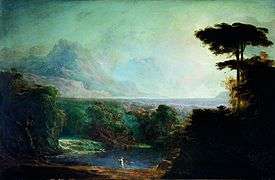 Alpheus and Arethusa by John Martin (1832)
Alpheus and Arethusa by John Martin (1832)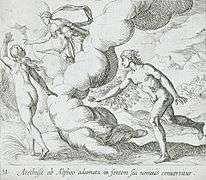 Arethusa Chased by Alpheus by Wilhelm Janson and Antonio Tempesta (1606)
Arethusa Chased by Alpheus by Wilhelm Janson and Antonio Tempesta (1606)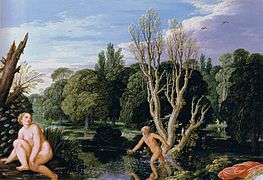 Alpheus and Arethusa by Johann König (probably 1610s)
Alpheus and Arethusa by Johann König (probably 1610s)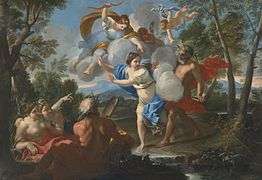 Alpheus and Arethusa by Luigi Garzi
Alpheus and Arethusa by Luigi Garzi Alpheus and Arethusa by Paolo de Matteis (1710)
Alpheus and Arethusa by Paolo de Matteis (1710)- Aréthuse et Alphée by Léopold Burthe (1847)
- Arethusa
- Scultore fiorentino, alfeo e aretusa, 1561-62
 Alpheus and Arethusa by Battista di Domenico Lorenzi (1568–70)
Alpheus and Arethusa by Battista di Domenico Lorenzi (1568–70)
See also
- Alfeios River
- Sarasvati River – Ancient river in the Indian subcontinent, the invisible or subterranean mystical river of Hinduism
References
- Lewis, "Two sides of the same coin", pp. 179–201.
- Schmitz, Leonhard (1867). "Alpheias". In William Smith (ed.). Dictionary of Greek and Roman Biography and Mythology. 1. Boston: Little, Brown and Company. pp. 133–134. Archived from the original on 2008-06-13.
- Hesiod, Theogony 338
- Pindar, Nemean Odes i. 1
- Pausanias, Description of Greece 4.30.2
- Homer, Iliad 5.45
- Plutarch, Quaestiones Graecae, 19
- Pseudo-Clement, Recognitions 10.21-23
- Pausanias, Description of Greece v. 7. § 2
- Comp. Scholiast on Pindar's Nemean Odes i. 3
- Roman, L., & Roman, M. (2010). Encyclopedia of Greek and Roman mythology., p. 56, at Google Books
- Ovid, Metamorphoses v. 572, &c.
- Comp. Serv. ad Virg. Ecl. x. 4
- Virgil, Aeneid iii. 694
- Statius, Silvae i. 2, 203
- Theb. i. 271, iv. 239
- Lucian, Dialogi Marini 3
- Roman, L., & Roman, M. (2010). Encyclopedia of Greek and Roman mythology., p. 56, at Google Books
- Pausanias, Description of Greece vi. 22. § 5
- Scholiast on Pindar's Pythian Odes ii. 12
- Pausanias, Description of Greece v. 14. § 5
- Scholiast on Pindar's Olympian Odes v. 10
- Strabo, Geographia vi. p. 270, viii. 343
- Seneca the Younger, Naturales quaestiones iii. 26
- Fulgent. Myth. iii. 12
- Plutarch, de Fluv. 19
- "RPC III, 309". Roman Provincial Coinage online.
![]()
Bibliography
- Virginia M. Lewis, "Two Sides of the Same Coin: The Ideology of Gelon’s Innovative Syracusan Tetradrachm", in Greek, Roman, and Byzantine Studies, 59 (2019), pp. 179–201.